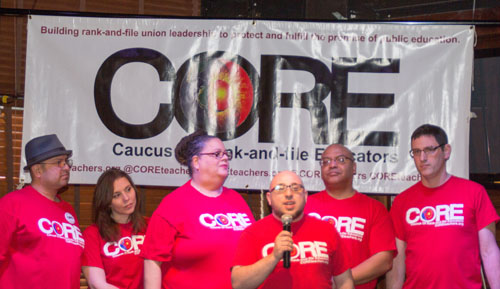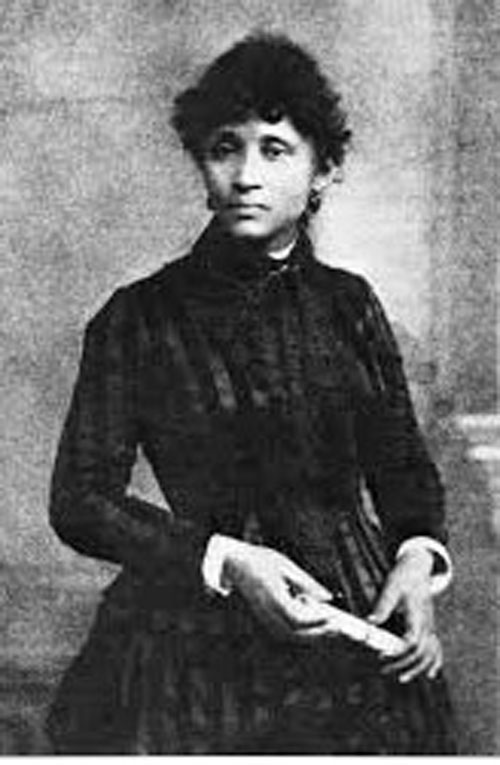Crossing the National Mall on 4th street, you pass between the glisteningly modern National Air and Space Museum and the sculpted brown stone of the National Museum of the American Indian to come face to face with what can only be described as a monument to bland austerity.
It was at the base of this concrete and glass slab that a band of public school teachers, university professors, librarians, parents, and students gathered to speak out against the nation’s current regime of testing students, firing teachers, and closing public schools.
For four straight days, speaker after speaker spoke, shouted, and sang into a microphone placed near the entry way of a building bearing the name of an American president who arguably did more to advance the well being of poor people than any other political leader in American history. The group railed at the building and its occupants – especially Secretary of Education Arne Duncan.
The speakers exhorted the audience to chant protestations to the building, turn their backs to it, shake their fists at it, and curse it.
Why so much anger thrown toward a very big, ugly building?
“You’re hurting children!” The crowd shouted. “You’re spreading injustice! You’re harming teachers! You’re ruining schools! You’re shredding democracy! You’re selling out the common good to private corporations!”
These are things, it would seem, worth getting upset about – if it weren’t happening in a capital city where getting upset is viewed as unseemly.
But even though the agitators gathered on the plaza in front of the DOE were mostly ordinary citizens of no obvious distinction, the speakers were anything but that. As
The Washington Post’s Valerie Strauss observed, the speaker roster included education historian and NYU professor “Diane Ravitch, Chicago Teachers Union President Karen Lewis, veteran educator Deborah Meier, early childhood expert Nancy Carlsson-Paige, and language acquisition expert Stephen Krashen.”
Writing at Strauss’ site, Amy Rothschild noted the event, called Occupy the DOE 2.0, drew “leading scholars and teachers, who have decades of classroom, school, and university leadership guiding them. They are demonstrating in front of the Education Department because the people working inside have ignored their message.”
At the website of
Mother Jones, one of the event organizer, Peggy Robertson explained the protest was organized because “liberal school advocates are deeply unhappy with President Barack Obama’s education reform agenda.” She called policies such as Race to the Top “No Child Left Behind on steroids.”
Writing at the online site of
Empower Magazine, Occupy participant, Denisha Jones explained that this was the second anniversary of the event. The original rationale for the event was to raise people’s awareness “about the dangers of high stakes standardized testing, school closings, for-profit charter schools, and the billionaires club that is destroying public education.”
Although the crowds for both events have been relatively small, the organizers and participants this year, Jones, maintained, have been pumped up significantly by recent events, such as the successful Chicago teachers strike and the boycott of standardized testing in Seattle and elsewhere.
The resistance tactic of boycotting or “opting out” of high-stakes testing was a focal point of the event. The first four speakers, who were the principal event organizers, each exhorted parents to exclude their children from the tests, teachers to refuse to give them, and students to refuse to take them.
But based on what the rest of the event’s speakers said, and conversations heard in the audience, it’s broadly acknowledged that problems with current education policies extend way beyond testing alone, and just saying no to tests is not viable in every situation.
Parent activist Leonie Haimson, and founder-leader of a grassroots group
Class Size Matters, warned that current education policies are headed toward a “two tiered system” in which more well-off parents get to send their children to schools with small class sizes and well-rounded curriculum, while less well off parents are relegated to schools with big class sizes, narrow, test-driven curriculum, and governance dominated by “big data” rather than research-based practices.
Early childhood education expert Nancy Carlson Page warned that the same kind of reforms damaging elementary-secondary education are being pushed down to the classroom of youngest children.
While she applauds the Obama administration’s recent proposals to make pre-K education more accessible, she worried that the designs of programs being pushed by the new policies would follow the same mistaken guidelines of Race to the Top and other edicts that mandate standards and accountability without regard to the developmental needs of young children.
“The expectation that little kids are going to learn the same things at the same rate at the same time is wrong,” Page declared.
Literacy expert Stephen Krashen warned about the unprecedented level of testing in American schools – “more than we have ever seen on the planet.” Krashen decried the “enormous costs” of the testing mandates – New York City and the state of Florida alone are expected to spend more than half-a-billion dollars each just to enable the Internet connections the tests require. He pointed out how in tough economic times these expenditures take away from more worthy basic needs like expanded breakfast and lunch programs, school nurses, and libraries with books.
And then there were the stories. Counter balancing the current fad to base education policy solely on numerical data – regardless of the merit of the source – this event offered an abundance of stories about the reality in schools today.
Katie Osgood who currently works on a child and adolescent inpatient psychiatric unit in Chicago recounted her experiences in dealing with the traumatic fallout of school reform measures.
“Every year I am getting more kids coming into our unit as a direct result of the pressures of high stakes testing,” she explained. “Kids not only feel the pressure themselves but they understand the pressures being put on teachers.”
“The busiest admission weekend in the history of our hospital was the week before the tests this year,” she observed.
Osgood also relayed incidents of children being traumatized by school closures and harsh discipline policies employed in charter schools that don’t follow the regulations that are required of traditional public schools.
“We’ve had incidents where students actually die when schools are closed and the children have to cross dangerous neighborhoods to get to their new schools,” she recounted. “Children also come to my hospital because they are depressed and angry that their friends have been physically hurt when they are transferred to new schools. One kid who was so afraid and angry he stopped going to school and was classified as mentally ill by the school administration.”
“We also see students traumatized by harsh discipline policies in charter schools – schools that punish students by making them run up and down stairs or stare at walls – and schools that charge parents fees for their children’s misbehavior. Then when kids refuse to go to these schools they are called sick. They aren’t sick. The charter school is sick.”
Numerous teachers and administrators spoke about being compelled to engage in education practices they believe compromise their professional ethics.
Teacher Kris Nielsen, formerly with Union County Public Schools in North Carolina and now in New York, compared academic targets based on test score results to retail sales quotas. “Kids are not dealt the same hands but have to meet the same quota, which isn’t fair,” he maintained. “Also the targets are meaningless to students.”
Chicago teacher Phil Cantor spoke about children in his school being rated and grouped by test scores with the “bubble kids” being targeted for more intense instruction because they have “the best chance of moving out school off probation.”
“Our students aren’t test scores,” Cantor declared. “Policies that only see them that way harm kids, and these policies are destroying public education around the country.”
Amidst the critiques of the current administration there were proposed solutions as well, including smaller class sizes, services that attend to students’ health, nutrition, and emotional needs, and increased access to libraries, art and music programs, and other academic pursuits that are often cast aside due to wave after wave of testing.
But make no mistake, the mood of the crowd was indeed angry, and when the throng gathered to march to the White House, their numbers grew from a few score to 200 – 300. As a police contingency escorted the demonstrators along the National Mall, onlookers shouted encouragement, with some jumping off the sidewalk to join in, so the crowd grew as it advanced down the street.
Do such outpourings make a difference? Who knows, but progressives everywhere need to understand that we are about to head into a very angry season. The same administration assaulting public schools is about to be the first Democratic presidential office to
cut Social Security and Medicare – the New Deal compacts that support the nation’s poor and middle class.
We should be angry. But this anger is too readily dismissed by the current cynicism dominating media outlets these days.
As
Richard Eskow recently observed, “It has become a tired rhetorical gambit of self-described ‘centrists,’ . . . to paint their opponents as agitated (presumably as a contrast to their own calm rationality). This maneuver is routinely deployed to imply that anyone who doesn’t embrace their ideology – and it
is an ideology – is overly emotional and therefore somewhat less rational than they are.”
Progressives who believe in the need for change can’t be deterred. . . .





